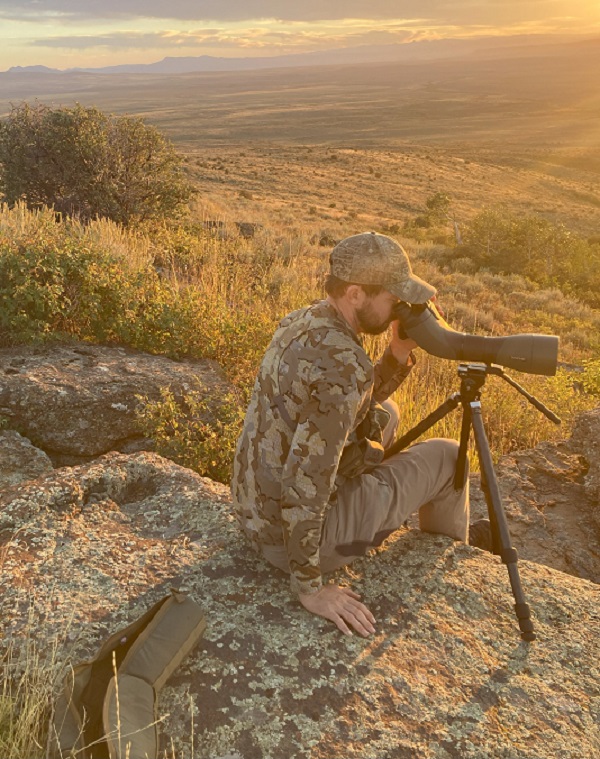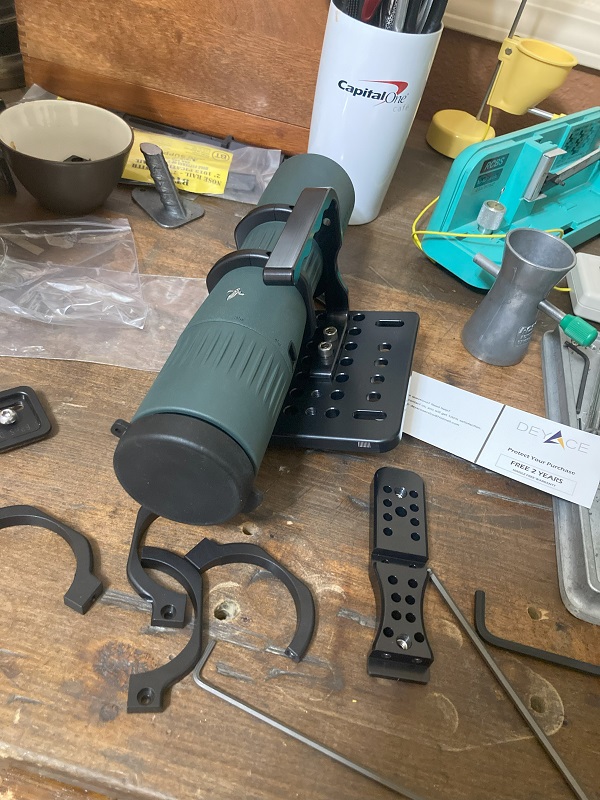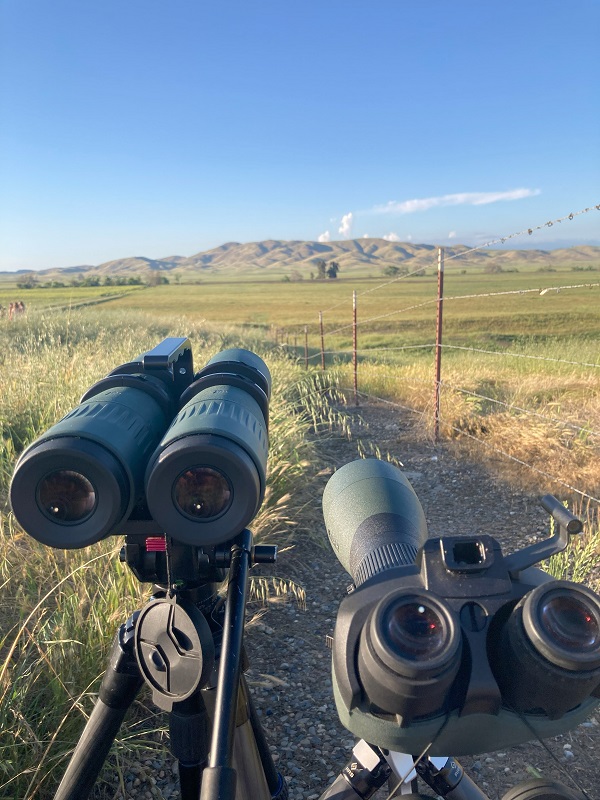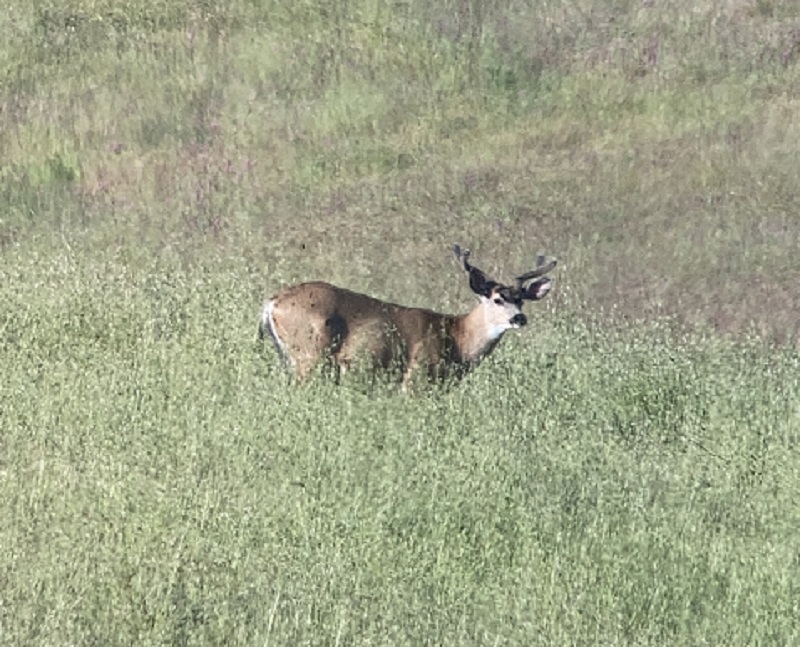
Why long-range glassing
Long-range glassing is an important part of my Western hunting toolkit. About half of the good bucks I have found or killed I spotted at distances between 1.5 and 4 miles. I have found that mature animals will often live in places that are not easily glassed unless you are quite close (usually TOO close) or very far away. Using high-magnification optics to find animals at long distances is one of my favorite and most effective techniques.
The gold standard: Swarovski BTX
Enter the BTX: Swarovski’s revolutionary eyepiece allows for binocular vision paired with their excellent 65mm, 85mm, 95mm, or 115mm objectives, offering a range of magnification, brightness, and overall size. Without getting too far into the weeds, I tested the 65mm, 85mm, and 95mm side by side back in January of 2022. I decided to keep the 85mm version for its good balance of FOV, overall size, and useable magnification at 30x– and 50x with the 1.7x magnification extender. This setup has been in my pack all over the West. I’ve used it for somewhere near 80 days in the field, and my only regret is not buying it sooner! More info here.
In my opinion, the BTX’s two compromises are bulk (and weight) and the fixed zoom. With 30x on the low end and 50x on the upper end (which is only helpful in good lighting conditions), it leaves something to be desired as a do-all western hunting optic.

Big eyes (dual spotters)
Until recently, if you wanted variable power, zooming objectives you were limited to a few giant setups by Docter and Kowa (read: crazy heavy and expensive), or using an adaptor to lock together two spotting scopes on a bracket. There are various options and configurations, none of which particularly interested me due to the bulk, weight, and optical compromises for my particular uses. That was until Swarovski introduced their STC 17-45x56mm mini spotting scope, and Adams Adaptor out of Arizona designed a bracket to fit them. After I looked through an STC spotting scope and saw an incredibly wide, flat FOV with exceptional image quality, I decided to take the plunge and see if the STC big eyes setup could replace my BTX. See STC here.
STC big eyes setup
As of writing this article, the only commercially available adaptor I am aware of is the Adams Adaptor. I received my set, and within about 10 minutes, I had two STCs locked down onto the bracket. From there, the user must individually adjust each scope within the bracket to 1) correctly set interpupillary distance (the distance between your pupils allowing for one image while looking through both eyes) and 2) adjust collimation (each individual scope perfectly centered vertically and horizontally).
Adams Adaptor has detailed instructional videos on how to do this. The process is fairly straightforward, but setting things up PERFECTLY took me multiple outings. My brain would “fix” an image showing me one clear view, but a few minutes of use would introduce eye strain and decreased resolution. After some trial and error, the process is now pretty easy and results in zero eye strain and excellent images. Note—because of the design of the STC scope, the adaptor will only work if your IPD is 2.56” or wider. Adams adaptor has videos on how to measure your IPD—definitely do this before ordering a set!

STC big eyes glassing experience overall
Some of this is very subjective, but I hope to answer some of your questions when considering the STC big eyes. The most significant functional difference is the ability to “zoom” with the STC setup. At 17x, the STC big eyes offer incredible FOV, resolution, and brightness. I compared the 17x to my Swarovski SLC HD 15×56 binoculars and found the STC to have only a slightly smaller FOV, with a noticeable increase in magnification and resolution. Low-light testing gave a very slight nod to the 15s for brightness, but after quite a bit of back and forth, I would not feel handicapped using the STCs and leaving the 15s at home.
With no big game seasons underway, I took the STC Big Eyes to my local mule deer winter range and then on a wild pig hunt. I found myself using them at 17x to search for deer at distances from 700 yards to about 2 miles, then zooming in for a better look. The fastest way to accomplish this is to close one eye, zoom that barrel to the maximum (40x), refocus, and repeat for the other eye. It only takes a few seconds to focus your second eye and give a nice, relaxed view through both eyes. You can do all of this without your eyes leaving the scope.
Zooming and Focusing
Setting the STC big eyes at intermediate powers is straightforward. There are no detents or “hard stops” between powers. At first, I would take my eyes out of the scope, set each barrel to the same magnification, and then refocus each eye. I figured out later than you can stay in the scope, close one eye and zoom the other barrel, then with both eyes open zoom the other barrel until the image is crisp through both eyes. It sounds complicated, but with some practice it becomes natural. I found the setup very easy to use at intermediate powers. In some situations, usually between 1-3 miles, I would set the scopes at 25x or 35x. It is very useful in conditions of mirage or low light, to find the maximum power that still looks “crisp” and glass at that power. Often times a little extra magnification is needed to help your eyes and brain recognize a deer easily at distance, and this setup allows you to use the ideal magnification for almost any situation or environmental condition.
STC Compromises
One of the compromises of the STCs is ease of use at high magnification. I am not an optical engineer, but I can tell you there is a tradeoff between FOV, eye relief, and critical eye placement. The STC scope has an incredible FOV and blows its small spotter competitors out of the water here. However, as magnification increases, the exit pupil decreases. Similarly, eye relief becomes shallower, and eye placement becomes more critical. All of that to say, the compromise for an excellent FOV and usable eye relief is somewhat critical eye placement to prevent “blackouts” in the image. The image is also noticeably darker at high magnification due to a small exit pupil. Overall, the eyebox is more forgiving in the BTX compared to the STC set at 30x. After using the STCs for a few hours, it bothers me less as my brain and eyes naturally adjust, but there is no question that the BTX is more user-friendly regarding eye placement and blackouts.
STC big eyes versus the BTX — Optical Qualities
Resolution
To test resolution, I purchased a 1951 USAF resolution chart from eBay. I set it up at a distance of 160 yards and compared both scopes at different times of day and into the fading light. I repeated this test out my front door multiple times to ensure my results were consistent. The limitation of this test is that there is no way to accurately verify the STCs are set on 30x because there is no mark on the STC between 25x and 35x. That being said, I got it very close.
In bright light, with a bit of mirage, both scopes were able to resolve down to the same group and element. If I really focused, there may be a slight edge to the BTX in showing a slightly more defined image at that element—but it is CLOSE.
In good, clean lighting conditions I was again able to resolve the same element in both scopes, but felt like the BTX gave a slightly more defined image.
In fading light I was not able to discern a difference in resolution between the BTX and the STC setup.
With both scopes at maximum power, in GOOD atmospheric conditions (40x for the STC and 50x with the 1.7x ME installed on the BTX), the BTX can resolve a few additional elements. 10x additional magnification is significant. However, with mirage present, the difference is marginal or nonexistent.
Suffice to say, the resolution chart confirms my suspicion that the BTX and STC are incredibly close in resolution power at equal magnification. The BTX will be able to resolve more at 50x, but good atmospheric conditions are needed (think sun setting at your back with no mirage).
FOV
The STC scope has excellent FOV. At equal magnification, there is a slight but real increase in FOV compared to the BTX. I tried to capture this in my digiscope images below. That being said, at magnification above 35x on the STCs, the eye placement is fairly critical. It is difficult for your eyes to “rove” through the entire FOV without inducing some blackouts. My impression of the STC is that the entire FOV is not easily usable at high magnification. At lower magnifications, the FOV is excellent and fully usable.

My photo editing skills are terrible, but you can see here the STC big eyes (right) provide a noticeable increase in FOV over the BTX (left) at equal magnification. This was difficult to show digiscoping, but notice how much additional image is present on the right side. Magnification is the same here.
Contrast and color
This one is subjective. The STC generally provides a brighter color bias with an almost too “white” color rendition for my taste. The BTX feels more natural in color rendition. I overall prefer the color bias of the BTX. In addition, I feel that the contrast is better in the BTX. This was most apparent while birdwatching but also noticeable when looking for deer. After spending hours in the STCs and BTX side by side, there is a notable “pop” in colors and contrast through the BTX, whereas the STC feels comparatively a little less vibrant. When considering the overall size of these optics, I would guess there are more optical elements and coatings in the longer BTX, which may be part of this. However, after using the STC for a few hours on a pig hunt, I did not wish for “better” optics. It is only side-by-side that this difference is apparent.
To sum it up, both offer incredible images taken at face value. For my eyes, the BTX provides a more pleasing image with vibrant colors and contrast.
Glassing into shadows
I made this a separate section because it was one of the notable differences between these two optics. At equal powers, the BTX seems to cut through the shade and resolve objects better in the shade. I was unable to reproduce this by placing the resolution chart in the shade, but it is noticeable in the field. This difference was more noticeable when glassing into the setting sun and peering into shaded hillsides. I think this is an important consideration for what we do as hunters. It is hard to say if this would result in finding more deer with the BTX; I’ll just say there is a noticeable difference to my eyes.

Ergonomics and usability
I prefer straight spotters and was willing to compromise on the BTX because of how useful binocular vision is for finding game. It is faster to switch between binoculars and spotting scope to relocate game with a straight spotter. For that reason alone, I prefer the STCs. Beyond that, the smaller overall package of the STCs balances better on a tripod, even with a long arca plate and perfectly balanced BTX. This meant smoother glassing with the STCs, less fiddling with tension knobs, and potentially being able to use a lighter tripod and head despite similar overall weight.
Focusing the STCs requires independently setting magnification and focus in each eye. The BTX is definitely easier to focus, but with some practice, I found the STC setup very easy to use. After some practice, it was seamless to go from searching at 17x, to zooming in and refocusing with the STC.
Overall, I found the STCs to have a small learning curve, after which they became nearly seamless in field use.
Size and weight
The overall weight of these two systems is very close. Once you factor in a tripod plate and carrying case, you’re looking at about 6.5 lbs for each (97oz for the STC setup vs 96oz for the BTX with extender)—essentially a wash. However, the BTX is much longer and taller. The STC’s are a significantly smaller package. I can easily fit them in a small day pack and carried them in the hydration bladder pouch of my daypack.

The STCs are significantly less bulky, although they weigh the same as my BTX 85. I can fit them in a small daypack, which is not possible with the BTX.
Cost
Cost is going to be similar. New, each setup is going to set you back around $5500 if you include the 1.7x extender on the BTX. I was able to get both setups on the used market (aside from the Adams Adapter) and saved quite a bit.
Digiscoping
I do not do very much digiscoping, but I will take a few pictures here and there. My setup is an iPhone SE with a phoneskope case. Both the BTX and STC work fine with this setup. The STC is easier to “zoom” and get a nice balance of brightness and resolution for the given conditions. The BTX you are stuck with either 30x or 50x. I did not test this extensively, because I am not much of a photographer.

Other considerations
As of now, there is no commercially available, packable carrying case for the STC big eyes. There may be something in the works from Adam’s Adapters but in the meantime, I may need to DIY something. I also have not packed the STC around long enough to know if it will stay horizontally collimated through heavy use. It has held collimation on one weekend-long hunt riding in the truck and my daypack. However, If one screw came loose, the system would fall out of collimation. I will be packing an Allen wrench just in case it needs to be adjusted or fixed in the field, and I plan to Loctite all screws. The BTX is undoubtedly a more robust system with plenty of available cases and covers.
My takeaway
The BTX has a very slight edge in resolution at equal magnification, better contrast, cuts through shade more effectively, has a great eye box, and is a well-vetted option for serious long-range glassing. The STC is overall more versatile and will cover a much larger range of glassing situations, but it requires a bit of effort to set up correctly. The BTX also offers more top-end magnification with the 1.7x ME, which can be useful during excellent lighting at extreme distances or for detailed field judging.
I am choosing to keep the STC big eyes. On several outings with both setups available, I found myself reaching for the STCs over the BTX. In my opinion, the versatility and ability to glass with the ideal magnification for just about any situation outweigh some of the optical benefits of the BTX. Over the years, I have wished for LESS low-end magnification on the BTX—something to bridge the gap between my chest binoculars and the 30x low end. The STC big eyes do just that, with an incredible field of view and very good optical qualities. I found myself using them at 17x most of the time and then zooming in to take a closer look or to glass very distant hillsides. In summary, the STC big eyes are an incredible tool that might not work for every hunter but certainly offers incredible flexibility in a packable size. If the BTX fits your hunting style, the STC big eyes deserve strong consideration as well. I will continue to update the discussion thread as I get more time behind this setup over the fall.
Comment or ask Will questions here.


















